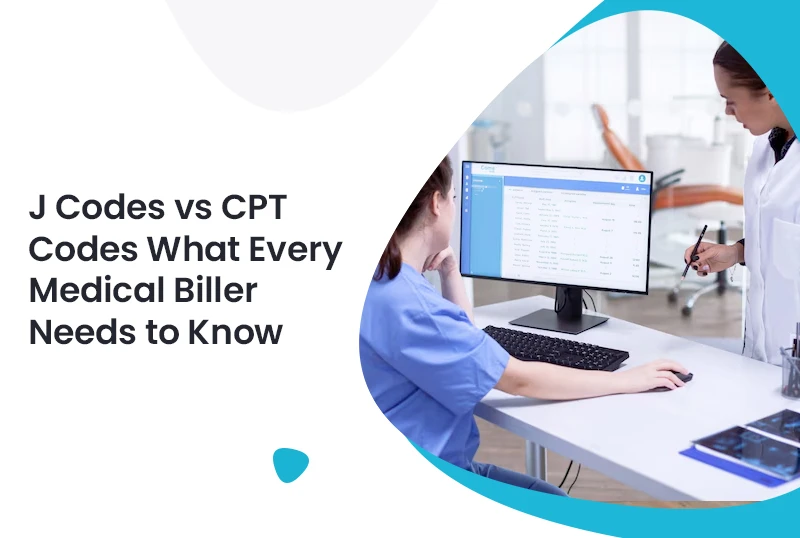Think medical billing is all about CPT codes? Think again.
Behind every in-office injection or specialty drug is a powerful billing tool that often gets less attention – J Codes.
These alphanumeric codes are the key to getting reimbursed for the medications you administer during patient visits. When used correctly, they keep your claims clean and your payments on time. When used incorrectly, they create confusion, delays, and lost revenue.
In this blog, we’re diving into the world of J Codes. You’ll learn what they are, how they differ from CPT codes, and why mastering them is essential for accurate billing and a healthier revenue cycle.
First Things First: What Even Are J Codes and CPT Codes?
Let’s rewind. In medical billing and coding, every action, medication, or procedure has a unique identifier – like a digital price tag.
- J Codes are the what-you-used codes.
Example: J1071 (testosterone injection) - CPT Codes are the what-you-did codes.
Example: 96372 (therapeutic injection)
You need both to get paid and get paid right.
J Codes: Essential Identifiers for Drug Billing
J Codes are a critical component in accurately billing for provider-administered medications. These alphanumeric codes, beginning with the letter “J,” are specifically designed to represent drugs and biologics that are supplied and administered in a clinical setting.
They are most commonly used to bill for:
- Injectable medications
- Chemotherapy agents
- Infused antibiotics
- Biologic therapies
Each J Code corresponds to a specific formulation, dosage, and method of administration. Proper usage ensures that payers understand not only the service performed but also the exact drug delivered during the encounter.
Think of J Codes as the barcode on the meds you just administered. No J Code? No payment.
The Evolution of J Codes and Why They Exist
Why not just use CPT codes for drugs?
Well, here’s the deal. CPT codes are owned by the American Medical Association (AMA) and meant solely to report services and procedures. But a new category became necessary as healthcare evolved and more providers began administering specialty drugs in-office.
CMS (Centers for Medicare & Medicaid Services) introduced J Codes to:
- Standardize billing for provider-administered medications
- Monitor usage of high-cost or high-risk drugs
- Improve efficiency in Medicare and commercial payer systems
You’ll never use J Codes for medications patients get from a pharmacy. These are strictly for drugs given directly by a provider during a visit.
CPT Codes: The Backbone of Procedure Billing
If J Codes represent what was used, CPT codes tell the story of what was done.
CPT codes are the standard language for describing medical, surgical, and diagnostic services. These five-digit numeric codes are published by the AMA and form the core of every claim submitted for reimbursement.
They are commonly used to bill for:
- Patient evaluations and office visits
- In-office or outpatient procedures
- Diagnostic tests and screenings
- Immunizations and injections
- Minor and major surgeries
Every CPT code reflects a clinical service that took place and precision matters. The wrong CPT code can delay claims, raise red flags, or result in underpayment. The right one helps maintain compliance, supports performance metrics, and keeps your revenue flowing.
Pairing CPT Codes with J Codes
When a provider-administered drug is involved, accurate reporting requires two things: the procedure and the product. CPT codes identify the clinical action, whereas J Codes indicate the medication or biologic that was used. For instance, if a nurse administers an intramuscular injection, CPT 96372 covers the injection service, while J1071 specifies the testosterone cypionate given. Both codes work together to provide a complete, billable snapshot of the visit. This pairing supports medical necessity, ensures proper documentation, and helps claims move through approval without bottlenecks.
Why Mixing Them Up Wrecks Your Reimbursement
Here’s where the pain hits your pocket: using the wrong code combo delays (or sometimes even flat-out kills) your payment.
Incorrect or missing J Codes can:
- Cause claim denials
- Trigger audits
- Lead to underpayment
This directly impacts your revenue cycle management healthcare process. When a claim gets denied, your team wastes time chasing paperwork. Your patients get frustrated. Your revenue dips.
Billing isn’t just about speed – it’s about strategy. The right codes = the right cash.
Real-Life Coding Scenarios You Can’t Ignore
Let’s get real. Here are some scenarios that play out more often than you’d expect:
Scenario 1: Missing J Code
A patient receives an in-office progesterone injection. CPT 96372 is billed, but the drug code is missing.
Result: Partial denial, only administration reimbursed.
Fix: Add J1050 for medroxyprogesterone acetate.
Scenario 2: Incorrect Procedure Code
A provider uses CPT 99211 (minimal visit) instead of 96372 for drug administration.
Result: Lower payment, flagged audit risk.
Fix: Use procedure-specific codes for injections (not generic visit codes)
Scenario 3: Overuse of Unclassified J Codes
Using J3490 too often slows everything down. It’s a placeholder for drugs that don’t yet have a code.
Fix: Use specific J Codes when available and pair with NDC numbers when J3490 is unavoidable.
J Codes vs CPT Codes – Let’s Make It Simple
| Feature | CPT Codes | J Codes |
| What it is | Procedure/service | Medication/drug |
| Format | 5-digit number | Alphanumeric (starts with “J”) |
| Example | 96372 – Injection admin | J1071 – Testosterone |
| Managed by | AMA | CMS |
Pro Tip: CPT + J Code = Clean claim with fewer delays.
Streamline Your Workflow with Expert Billing Services
Running a practice is hard enough but Coding shouldn’t be what keeps you up at night.
That’s where a medical billing service comes in.
Here’s what a pro team does:
- Applies payer-specific rules automatically
- Tracks modifier usage, bundling edits, and units
- Uses tools to prevent undercoding or overcoding
- Flags documentation mismatches before submission
With the right partner, you can:
- Cut rejections by 50% or more
- Maintain a higher claim success rate
- Free up time for patient care, not paperwork
Accurate coding supports better care, faster payments, and a healthier practice.
The Compliance Connection You Can’t Ignore
Still think this is all about billing?
Here’s the bigger picture: clean coding also helps with medical credentialing services.
Insurance payers want providers who follow the rules. If your claims are full of mismatches and unclassified codes, you risk:
- Credentialing delays
- Contract terminations
- Audit scrutiny
Using the correct J and CPT Codes builds credibility and keeps your revenue and reputation protected.
Let’s Wrap It Up: Why All This Matters
You don’t need to memorize a thousand codes. But you do need to know when to use J Codes and when to use CPT Codes
CPT = the service
J Code = the drug
Together = complete claim = faster payment
Whether you’re a solo practice or a multi-provider clinic, the right medical billing service can help ensure every code is on point, every time.
So… what’s your code combo game looking like?
FAQs: Quick Answers for Busy Billers
1. Can I use a CPT code to bill for a drug?
Nope. CPT is for procedures. Drugs go under J Codes.
2. Why do I need both a CPT and J Code on some claims?
Because one shows what you did, and the other shows what you used. It’s a two-part story insurers need.
3. Do insurance companies reject claims without J Codes?
Yes, especially for injectable drugs.
4. How can billing partners help?
Expert billing services (like us!) catch these details, reduce denials, and improve your payment speed.







